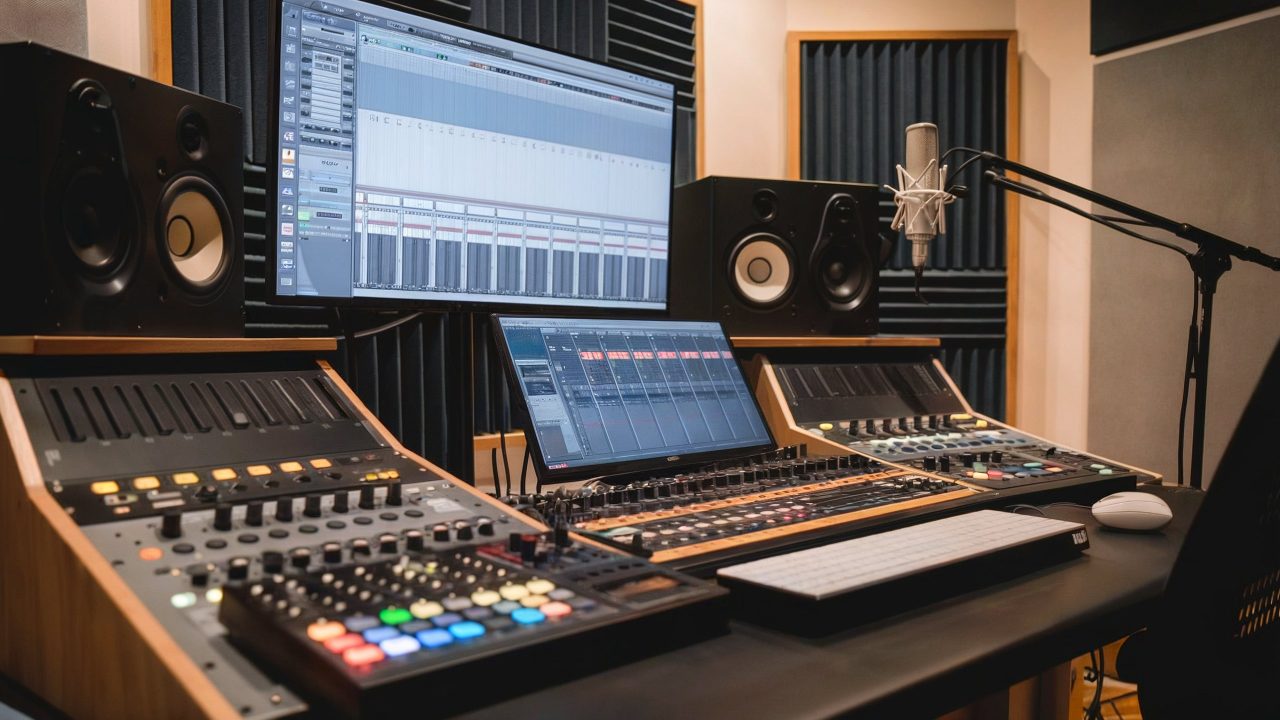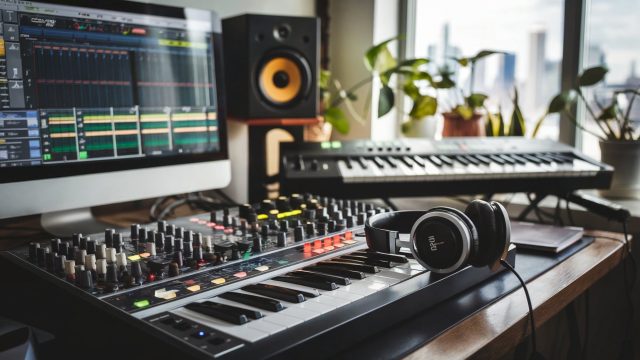DAW, Media, Recording: Unlocking the Power of Music Production In today’s digital age, music production has become more accessible than ever, thanks to advances in technology. Digital Audio Workstations (DAWs), media, and recording tools have revolutionized how music is created, recorded, and shared. Whether you’re an aspiring music producer, a recording artist, or someone interested...
DAW, Media, Recording: Unlocking the Power of Music Production

DAW, Media, Recording: Unlocking the Power of Music Production
In today’s digital age, music production has become more accessible than ever, thanks to advances in technology. Digital Audio Workstations (DAWs), media, and recording tools have revolutionized how music is created, recorded, and shared. Whether you’re an aspiring music producer, a recording artist, or someone interested in sound design, understanding these tools is essential for unlocking your creative potential.
In this post, we’ll explore what DAWs are, how media and recording technologies have transformed the music industry, and how you can start using these tools to bring your musical ideas to life.
What Is a DAW?
A Digital Audio Workstation (DAW) is a software platform that allows you to create, record, edit, and produce music. DAWs have become the heart of modern music production, offering a wide range of tools for composing, arranging, mixing, and mastering tracks. Whether you’re working on electronic beats, live instrument recordings, or soundscapes for film, a DAW provides all the features you need to bring your music to life.
Popular DAWs:
Ableton Live: Known for its intuitive interface and real-time performance capabilities, Ableton Live is a favorite among electronic music producers and live performers.
Logic Pro: Developed by Apple, Logic Pro is a powerful DAW that offers a wide range of instruments, effects, and advanced production tools, making it a go-to choice for professional producers and songwriters.
FL Studio: FL Studio is popular for its user-friendly interface and robust features for beat-making and electronic music production. It’s widely used by producers across various genres.
Pro Tools: Pro Tools is considered the industry standard in professional recording studios, offering advanced recording, editing, and mixing features for high-quality audio production.
Cubase: Cubase is a versatile DAW that offers strong MIDI capabilities, making it ideal for composers and producers who work with virtual instruments and complex arrangements.
Key Features of a DAW:
Audio Recording: Record vocals, instruments, and live performances directly into the software.
MIDI Sequencing: Create and arrange music using MIDI instruments, virtual synths, and sample libraries.
Editing: Cut, trim, and manipulate audio clips, MIDI data, and other elements to shape your tracks.
Mixing: Balance levels, add effects, and apply processing to individual tracks to achieve a polished mix.
Mastering: Finalize your track with mastering tools to ensure it sounds great across all playback systems.
How DAWs Have Transformed Music Production
Before the rise of DAWs, music production was primarily done in expensive recording studios with analog equipment. The process was complex, time-consuming, and often required a team of engineers and producers. Today, DAWs have democratized music production by allowing anyone with a computer and the right software to produce professional-quality music from the comfort of their home.
Advantages of DAWs:
Accessibility: DAWs make music production accessible to beginners and professionals alike. You no longer need to rent a recording studio or invest in expensive equipment to create high-quality music.
Flexibility: With a DAW, you can work on your music at any time and experiment with different ideas. You have the freedom to create, edit, and refine your tracks at your own pace.
Cost-Effective: While professional recording studios can be costly, a DAW allows you to produce music on a budget. Many DAWs offer free or affordable versions, making it easy to get started.
Collaboration: DAWs make it easy to collaborate with other musicians and producers remotely. You can share project files, work on tracks together, and exchange ideas without being in the same physical location.

Media and Recording: Bringing Your Music to Life
Recording and media technologies play a crucial role in capturing and sharing your music. Whether you’re recording vocals, instruments, or creating digital compositions, understanding the basics of recording and media production is essential for bringing your music to life.
1. Recording Audio
Recording audio is a fundamental aspect of music production. Whether you’re capturing live instruments, vocals, or sound effects, the quality of your recordings can make or break your final product.
Essential Recording Equipment:
Microphones: Microphones are used to capture sound and convert it into an electrical signal that can be recorded in your DAW. Different microphones are suited for different purposes (e.g., condenser mics for vocals, dynamic mics for live instruments).
Audio Interface: An audio interface is a device that connects your microphones and instruments to your computer, allowing you to record high-quality audio into your DAW. It converts analog signals into digital data that your DAW can process.
Headphones and Monitors: Quality headphones and studio monitors are essential for accurately monitoring your recordings and mixes. They allow you to hear the details of your tracks and make informed decisions during the production process.
2. MIDI and Virtual Instruments
In addition to recording live audio, DAWs allow you to create music using MIDI (Musical Instrument Digital Interface) and virtual instruments. MIDI is a digital protocol that allows your computer to communicate with virtual instruments, synthesizers, and other MIDI-enabled devices.
Benefits of MIDI and Virtual Instruments:
Wide Range of Sounds: Virtual instruments offer a vast library of sounds, from realistic pianos and strings to electronic synths and drums. You can use MIDI to create and control these sounds within your DAW.
Editability: Unlike audio recordings, MIDI data is fully editable. You can change notes, adjust timing, and experiment with different instruments without re-recording.
Cost-Effective: Virtual instruments eliminate the need for expensive hardware synthesizers and instruments. Many DAWs come with built-in virtual instruments, and there are countless third-party plugins available for download.
3. Mixing and Mastering
Once you’ve recorded your tracks and arranged your composition, the next step is mixing and mastering. Mixing involves balancing the levels of individual tracks, applying effects, and creating a cohesive sound. Mastering is the final step in the production process, where the track is polished to ensure it sounds great across different playback systems (e.g., speakers, headphones, car stereos).
Key Mixing Techniques:
EQ (Equalization): Adjusting the frequency balance of your tracks to ensure that each element sits well in the mix.
Compression: Controlling the dynamic range of your tracks to ensure consistent levels and punchiness.
Reverb and Delay: Adding space and depth to your tracks by applying reverb and delay effects.
Mastering involves preparing your track for distribution by ensuring it meets the technical requirements for different platforms and sounds consistent with other commercially released music.
The Role of Media in Music Distribution
Once your track is complete, media plays a crucial role in how your music is distributed and shared with the world. Digital media platforms like Spotify, Apple Music, YouTube, and SoundCloud have transformed the way music is consumed, making it easier than ever for independent artists to reach a global audience.
Key Media Platforms for Musicians:
Streaming Services: Platforms like Spotify, Apple Music, and Tidal allow you to distribute your music to a global audience. These platforms provide opportunities for independent artists to gain exposure and build a fanbase.
Social Media: Social media platforms like Instagram, TikTok, and YouTube are powerful tools for promoting your music and connecting with fans. Many artists have gained popularity by sharing their music and engaging with listeners on social media.
Content Creation: Creating content such as music videos, live performances, and behind-the-scenes footage can help you build your brand and reach new audiences. Media creation is an essential aspect of modern music promotion.
How to Get Started with DAWs, Media, and Recording
Getting started with music production doesn’t have to be intimidating. Here are some steps to help you begin your journey into the world of DAWs, media, and recording:
1. Choose a DAW
Select a DAW that fits your needs and budget. Many DAWs offer free or trial versions, so you can experiment with different platforms before committing to one.
2. Invest in Basic Equipment
Start with the essentials, such as a microphone, audio interface, and headphones. As you progress, you can expand your setup with additional gear and virtual instruments.
3. Learn the Basics
Take the time to learn the fundamentals of recording, MIDI, mixing, and mastering. There are countless online tutorials, courses, and communities dedicated to music production that can help you develop your skills.
4. Experiment and Create
Don’t be afraid to experiment and try new things. The beauty of music production is that there are no rules—let your creativity guide you as you explore different sounds, techniques, and ideas.
5. Share Your Music
Once you’ve created your music, share it with the world! Distribute your tracks on streaming platforms, engage with your audience on social media, and collaborate with other artists to grow your reach.
Conclusion: Embrace the Power of Music Production
The combination of DAWs, media, and recording technology has democratized music production, allowing anyone with a passion for music to create, record, and share their work. Whether you’re a beginner or an experienced musician, these tools offer endless possibilities for creative expression and innovation.
At Musicogroove, we offer personalized lessons in music production, recording, and media creation. Our experienced instructors can help you master the tools of the trade
